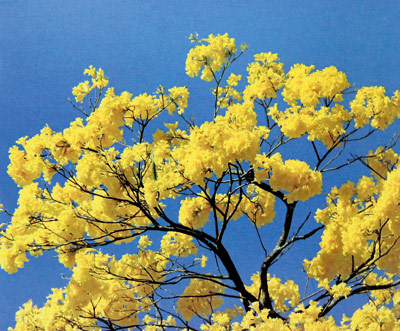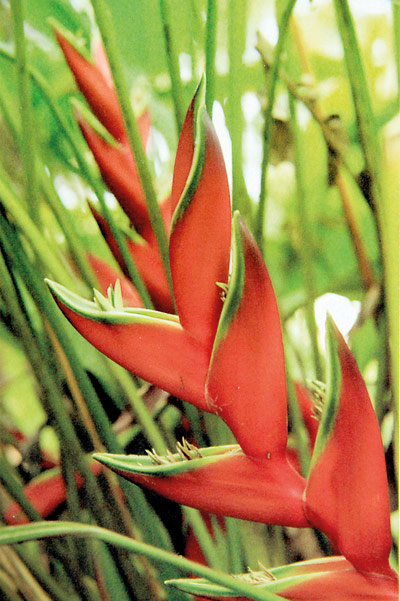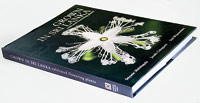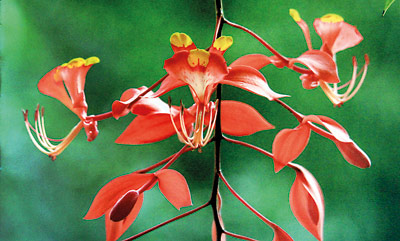Colourful outsiders that took root in our land

Yellow poui or Yellow or Golden Trumpet Tree
You can’t miss it when the ‘pink tree’ makes its brief but spectacular appearance in the capital and after a few glorious days, carpets the pavements with a thick mantle of delicate petals. Like many of the flowering trees we take for granted, the Tabebuia rosea, to give it its scientific name, is not a native of this country and in fact, was introduced to Sri Lanka from tropical America.
Many of us are wont to marvel at the numerous flowering plants and trees that Sri Lanka is now home to which show themselves in bursts of colour at various times of year or even flower or fruit steadily throughout but find ourselves woefully ignorant when it comes to identifying them. We all know a few like the tree “easily recognised by its showy bunches of scarlet flowers and light green, triangular leaflets” that come April will herald the Sinhala and Tamil New Year – the Erabadu, or Indian coral tree, known in Tamil as Mulmurukku. The Erabadu’s bark, leaves and seeds are used in Ayurveda but did you know that “in Hindu weddings, a branch is kept near the manavarai (a decorative wedding seat) as it is believed this plant can grow anywhere. It is believed that like the plant, the marriage is supposed to survive anything”.
‘Grown in Sri Lanka- cultivated flowering plants’ published by the National Trust of Sri Lanka is one of those useful books which you can see yourself referring and returning to often for its practical value. A companion volume to ‘Flowering Plants commonly encountered in Sri Lankan habitat’, this book aims to acquaint us with plants commonly grown here, many of which have been introduced to this country over the years and which have now become an integral part of our landscape.
Neatly presented, with common name, English, Sinhala and Tamil names, as well as scientific name, each plant is carefully described to aid identification. While filling in the gaps in our knowledge, each brief account also kindles further interest. If you are in Kandy, passing by the Peradeniya Botanical Gardens, you might want to look out for the ornamental tree with its cascading flowers known by its colloquial name of Kukul kakul that stands on its boundary. The Pride of Burma or Amherstia nobilis we learn, was discovered in the forests of Burma and named after Lady Sarah Amherst, wife of the Governor of Burma (now Myanmar). “This exquisite tree has delicate vermilion flowers that look like exotic little birds hanging down in long bunches, each about 30cm in length.”

Pride of Burma
Written in simple language sans the technical terminology one would usually find in a book compiled by three biologists, it is full of fascinating information – did you know that crab claws ( Heliconias) are relatives of the banana family or that Gotukola (Asian pennywort – English name) belongs to the parsley family?
The book’s authors are well known in their field and eminently qualified. Dr. Sriyanie Miththapala, presently a consultant to the Sri Lanka Country Office of the IUCN –International Union for the Conservation of Nature has a PhD in Wildlife and Range Sciences from the University of Florida. A natural history writer with many publications to her credit including three books for children co-authored with her father (on mammals, birds and butterflies of Sri Lanka), Dr. Miththapala is a past principal of Ladies’ College, Colombo.
| Book facts: Grown in Sri Lanka-cultivated flowering plants by Sriyanie Miththapala, Janaki Galappatti and Siril Wijesundara |
A vastly experienced teacher, Dr. Janaki Galappatti was Co-Vice Principal of Ladies’ College and has a great interest in developing innovative teaching methodologies. Dr. Galappatti has a PhD in plant pathology from the University of Cambridge and has lectured at the Post Graduate Institute of Agriculture, University of Peradeniya and at the Open University.
Dr. Siril Wijesundera was Director General of the National Botanic Gardens, Sri Lanka and serves on several national advisory committees on biodiversity and species conservation such as the National Species Conservation Advisory Group. He has a PhD in Biology from the City University, New York and has co-authored many botanical books on trees of Sri Lanka and one on orchids.
The book begins with an introduction to the role played by plants in the lives of people, an overview of trends of cultivation in this country touching on the dark side of agricultural advancement – use of toxic chemicals and expansion of monoculture at the expense of biodiversity. A section on recognising plants may take the reader back to a welcome quick dive into schoolday botany lessons.
Three sections follow- the first, plants grown for their beauty, includes flowering trees and many everyday garden plants like balsams, shoeflowers and coleus. The second, plants grown for their products, has a comprehensive and detailed collection going from medicinal plants like Aloe vera and hathawariya to commercial crops like tea, rubber, cinnamon to common fruits and vegetables. Here we find plants grown for food and beverage, spices and oils, medicine, timber and thatch, fibres and latex.
All along there is fascinating information behind seemingly common plants. Take Artocarpus altilis – the Breadfruit tree (Del in Sinhala or era pila in Tamil). The book enlightens us that it is native to the Pacific islands and Southeast Asia and is associated with Captain Bligh and the Mutiny on the Bounty. “Bligh had been sent to Tahiti to collect breadfruit plants to be taken to the Caribbean for cultivation, to provide food for the slaves on British sugar plantations. He managed to ecape from Tahiti with a few plants but the slaves refused to eat the fruits!”It seems the oldest breadfuit tree in Sri Lanka brought by the Dutch, is still fruiting in the Akersloot Bastion of the Galle Fort.
The last, smaller section looks at plants grown for their services and here there is some overlap, the authors concede. These include shade trees like the Australian red cedar and the Rain tree which is also now used for making furniture. The Bo (Ficus religiosa) which has special religious and cultural significance to Sri Lankans is found here with the text giving its history and mentioning the duty entrusted to the Director General of Botanic Gardens – that of ensuring the continued health of the oldest tree in the world – the Sacred Bo tree at Anuradhapura- the world’s oldest living historically authenticated tree dating from 288 BC.

Heliconia or crab claws
Well illustrated with clear colour photographs contributed by several well known photographers, the focus is on easy identification. A glossary of botanical terms and name indexes complete a most readable and informative book.
Launched last month, the book is part of the National Trust’s invaluable effort aimed at providing thoughtfully compiled and educational books on various aspects of our heritage to the public. Priced at Rs. 4,800, this hardcover book is now at Vijitha Yapa Bookshops and will be available at other leading bookshops shortly.


